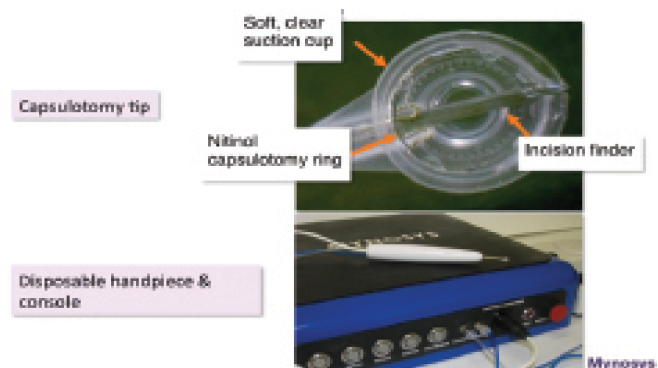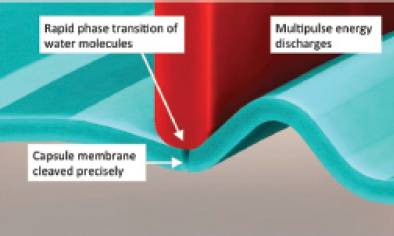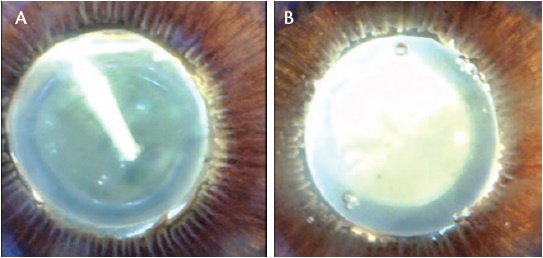
In an age that demands extreme precision and safety in cataract surgery, any new technology that can eliminate manual steps of the procedure is highly desirable. Although some surgeons have adopted the use of femtosecond lasers for cataract surgery, in particular for capsulotomy creation, others have decided against using them for a number of reasons, including cost.

Figure 1. The Zepto capsulotomy system is composed of a clear suction cup, nitinol capsulotomy ring, incision finder, disposable handpiece, and power console.
A nonlaser alternative designed to create a continuous curvilinear capsulotomy of about 5.2 mm, the Zepto capsulotomy system (Mynosys) provides cataract surgeons with an accurate, reproducible, automated, and affordable technology to perform one of the most crucial steps in cataract surgery. The device, which resembles a vitrectomy unit, uses low-energy, precision-pulse technology to create a capsulotomy independent of pupillary size, corneal clarity, or lens density. Its disposable tip, inserted through a 2.4- to 2.2-mm incision, results in a quick, elegant, and instantaneous capsulotomy method that can reduce overall surgical time.
HOW DOES IT WORK?
The Zepto consists of a clear silicone suction cup that is applied to the capsule, a foldable nitinol (an alloy of nickel and titanium) capsulotomy ring, an incision finder that helps the device pass through the incision, a disposable handpiece, and a power console (Figure 1).

Figure 2. A cleavage plane is created in the capsular membrane with low-energy, precision-pulse technology.

Figure 3. Zonular safety in manual capsulorrhexis (A) and Zepto capsulotomy (B).
Once the nitinol ring of the Zepto is inserted through a small incision in the eye, the push rod is retracted, and the device unfolds to a 360º circle, allowing the surgeon to align the product on the capsular bag or center it on the pupil. Following alignment, suction is applied to ensure good contact with the capsule, and then a pulse of energy is delivered in milliseconds to the nitinol ring, triggering a rapid phase transition of water molecules that are trapped between the device and the capsular membrane. This phase change causes instantaneous creation of a cleavage plane—the capsulotomy—in the capsular membrane (Figure 2).
ADVANTAGES
There are a number of advantages of the Zepto compared with the femtosecond laser.
No. 1. It can be used in eyes with corneal opacity. Because the Zepto creates a perfect capsulotomy independent of pupillary size, corneal clarity, and lens density, it can be positioned underneath the iris in corneas that do not allow good visualization.
No. 2. It induces no significant temperature change in the eye. In studies performed by Mynosys, the temperature rose was in the anterior chamber as this device was used—no more than 2.01º C in 3.69 seconds.
No. 3. It promotes zonular safety and maximizes capsular edge strength. According to the company, the Zepto device applies no stress on the zonules, as seen on video analysis (Figure 3). In a study of 46 paired human cadaver eyes (Zepto capsulotomy and manual continuous curvilinear capsulorhexis or Zepto and femtosecond laser capsulotomy), the capsulotomies created with the Zepto device were up to three times stronger than the capsular openings created manually or with the femtosecond laser (Figure 4).

Figure 4. Tensile strength of manual capsulorhexis (top) versus Zepto capsulotomy (bottom) in a paired human cadaver eye study (A). The tensile strength was better across all paired eyes in the Zepto group than the femtosecond laser (B) and manual capsulorhexis (C) groups..
CONCLUSION
The automated Zepto system creates a perfect capsulotomy every time in a matter of seconds. It can be used in standard cataract surgery and even in eyes with small pupils—a major advantage compared with the femtosecond laser. Also, it is a more economical way to perform an automatic capsulotomy compared with the femtosecond laser.
Mynosys hopes to receive the CE Mark for the Zepto capsulotomy system in the near future, and the company is seeking 510(k) clearance from the FDA. Surgery in the first sighted patients will be performed before the end of the year.
Mark A. Kontos, MD
• senior partner, Empire Eye Physicians, Spokane, Idaho
• mkontos58@gmail.com
• financial disclosure: member, medical advisory board, Mynosys


